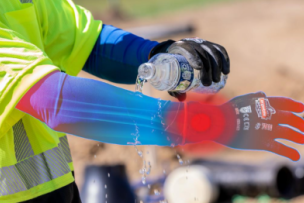For more than 50 years, DuPont Personal Protection (DPP) has been creating groundbreaking solutions that protect industrial professionals around the globe. DPP brings together some of the most trusted names in personal protective equipment (PPE)—Tyvek®, Tychem®, Nomex® and Kevlar®—to provide unparalleled solutions that protect workers against chemical, thermal, electric arc, mechanical and other workplace hazards.
The invention of spraying machines in the late 1800s transformed commercial painting, boosting productivity in industries from shipbuilding to construction and railways. It also created new risks for workers.
More than a century later, regulators are still identifying some of the hazards, and safety equipment producers such as DuPont are devising increasingly effective tools, such as Tyvek® coveralls and garments, to counter them.
“The principal hazards associated with the spray application of paints and other coatings are related to the components in the paint or coating, as well as the application process itself,” the Wilmington, Delaware-based company says in a pamphlet.
The U.S. Occupational Safety and Health Administration, the top workplace safety regulator, addresses those hazards in a variety of regulations, some tailored to specific industries such as construction and shipbuilding.
“During spray-painting operations, workers are at a greater risk of exposure to hazardous substances than when they are painting with a brush or roller,” the agency explains in a pamphlet on risks to ship painters.
Spray nozzles propel paint particles into the air, heightening the release of hazardous vapors, OSHA says, and the work is often done in confined spaces that, if not correctly ventilated, “can cause sickness or death for workers.”
Depending on the environment and the job, the agency requires both respirators to protect painters’ airways and coveralls to protect their skin from contact with toxins.
Airborne Liquids, Solid Aerosols
For less sprawling operations such as applying paints and coatings to boats and small watercraft, spray booths are typically used, both to curb fire risk and limit exposure, since the mix of solvents, pigments and additives in coatings can cause harm by either inhalation or skin contact.
In an effective spray booth, painters typically encounter only small airborne liquid drops or solid aerosols that range from 0.5 microns to larger than 10 microns, depending on the equipment used, DuPont says. A micron is one-millionth of a meter.










Talk to Us!
Leave a reply
Your email address will not be published. Required fields are marked *